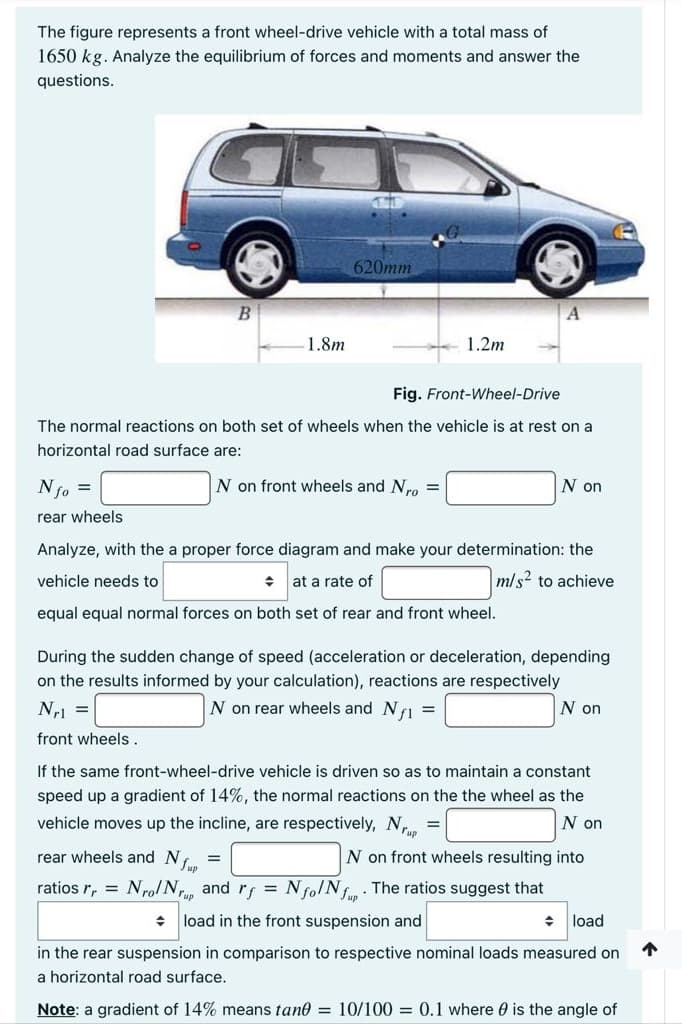G. 620mm 1.8m 1.2m
International Edition---engineering Mechanics: Statics, 4th Edition
4th Edition
ISBN:9781305501607
Author:Andrew Pytel And Jaan Kiusalaas
Publisher:Andrew Pytel And Jaan Kiusalaas
Chapter7: Dry Friction
Section: Chapter Questions
Problem 7.23P: The 40-lb spool is suspended from the hanger GA and rests against a vertical wall. The center of...
Related questions
Question

Transcribed Image Text:The figure represents a front wheel-drive vehicle with a total mass of
1650 kg. Analyze the equilibrium of forces and moments and answer the
questions.
620mm
1.8m
1.2m
Fig. Front-Wheel-Drive
The normal reactions on both set of wheels when the vehicle is at rest on a
horizontal road surface are:
Nfo =
N on front wheels and Nro =
N on
rear wheels
Analyze, with the a proper force diagram and make your determination: the
vehicle needs to
at a rate of
mls2 to achieve
equal equal normal forces on both set of rear and front wheel.
During the sudden change of speed (acceleration or deceleration, depending
on the results informed by your calculation), reactions are respectively
N1 =
N on rear wheels and NI =
N on
front wheels.
If the same front-wheel-drive vehicle is driven so as to maintain a constant
speed up a gradient of 14%, the normal reactions on the the wheel as the
vehicle moves up the incline, are respectively, N, =
N on
rear wheels and Nf.
N on front wheels resulting into
%3D
ratios r, = NrolN and rf = Nfo/Nf. The ratios suggest that
* load in the front suspension and
load
in the rear suspension in comparison to respective nominal loads measured on
a horizontal road surface.
Note: a gradient of 14% means tane = 10/100 = 0.1 where 0 is the angle of
![In a SHM (Simple Harmonic Motion), a point in horizontal motion passes a
fixed point A of coordinates x, and point B of coordinates x, with the same
speed. If AB =
that it takes Ata-b
300mm, assuming that point A is at the left of point B, and
= 3sec to move from A to B and Atp-b
4sec to move
outward and then back to B.
Analyze the SHM and then calculate:
1. The frequency:
• and period of the motion
2. Calculate the amplitude of the SHM motion
3. The equation of motion is x(t) =
cos(
%3D
t + p.) [mm]
4. The magnitude of the speed at A, is vA =
m/s and the
acceleration at B is a p =
m/s-2](/v2/_next/image?url=https%3A%2F%2Fcontent.bartleby.com%2Fqna-images%2Fquestion%2F8206f311-3848-419c-b025-0ee9c2273bcc%2Ff58dd69a-1286-416b-b16d-c021a6cbe8e8%2Fcx14sri_processed.jpeg&w=3840&q=75)
Transcribed Image Text:In a SHM (Simple Harmonic Motion), a point in horizontal motion passes a
fixed point A of coordinates x, and point B of coordinates x, with the same
speed. If AB =
that it takes Ata-b
300mm, assuming that point A is at the left of point B, and
= 3sec to move from A to B and Atp-b
4sec to move
outward and then back to B.
Analyze the SHM and then calculate:
1. The frequency:
• and period of the motion
2. Calculate the amplitude of the SHM motion
3. The equation of motion is x(t) =
cos(
%3D
t + p.) [mm]
4. The magnitude of the speed at A, is vA =
m/s and the
acceleration at B is a p =
m/s-2
Expert Solution
This question has been solved!
Explore an expertly crafted, step-by-step solution for a thorough understanding of key concepts.
Step by step
Solved in 2 steps with 2 images

Recommended textbooks for you

International Edition---engineering Mechanics: St…
Mechanical Engineering
ISBN:
9781305501607
Author:
Andrew Pytel And Jaan Kiusalaas
Publisher:
CENGAGE L

International Edition---engineering Mechanics: St…
Mechanical Engineering
ISBN:
9781305501607
Author:
Andrew Pytel And Jaan Kiusalaas
Publisher:
CENGAGE L